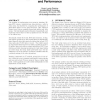Free Online Productivity Tools
i2Speak
i2Symbol
i2OCR
iTex2Img
iWeb2Print
iWeb2Shot
i2Type
iPdf2Split
iPdf2Merge
i2Bopomofo
i2Arabic
i2Style
i2Image
i2PDF
iLatex2Rtf
Sci2ools
ERLANG
2003
ACM
2003
ACM
A study of Erlang ETS table implementations and performance
The viability of implementing an in-memory database, Erlang ETS, using a relatively-new data structure, called a Judy array, was studied by comparing the performance of ETS tables based on four data structures: AVL balanced binary trees, B-trees, resizable linear hash tables, and Judy arrays. The benchmarks used workloads of sequentially- and randomly-ordered keys at table populations from 700 keys to 54 million keys. Benchmark results show that ETS table insertion, lookup, and update operations on Judy-based tables are significantly faster than all other table types for tables that exceed CPU data cache size (70,000 keys or more). The relative speed of Judy-based tables improves as table populations grow to 54 million keys and memory usage approaches 3GB. Term deletion and table traversal operations by Judy-based tables are slower than the linear hash table-based type, but the additional cost of the deletion operation is smaller than the combined savings of the other operations. Res...
Related Content
| Added | 05 Jul 2010 |
| Updated | 05 Jul 2010 |
| Type | Conference |
| Year | 2003 |
| Where | ERLANG |
| Authors | Scott Lystig Fritchie |
Comments (0)

